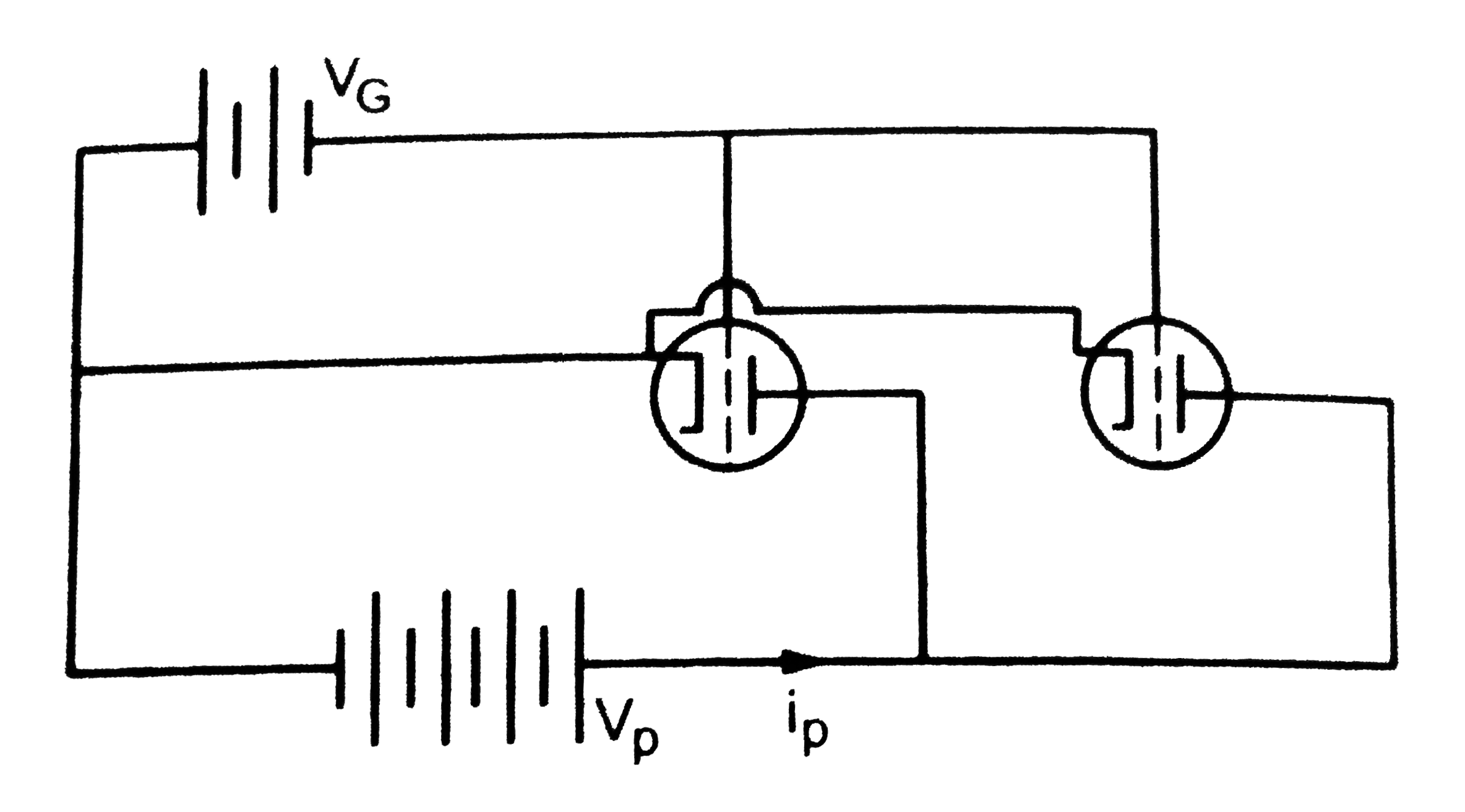Figure shows two identical triode tubes connected in paralle. The anodes are connected together, the grids are connected together and the cathodes are connected together. Show that the equivalent plate resistance is half of the individual plate resistance, the equivalent mutual conductance is double the individual mutual conductance and the equivalent amplification factor is the same as the individual amplification factor.
 Solution in Gujrati
Solution in Gujrati
Step by step video & image solution for Figure shows two identical triode tubes connected in paralle. The anodes are connected together, the grids are connected together and the cathodes are connected together. Show that the equivalent plate resistance is half of the individual plate resistance, the equivalent mutual conductance is double the individual mutual conductance and the equivalent amplification factor is the same as the individual amplification factor. by Physics experts to help you in doubts & scoring excellent marks in Class 12 exams.
Updated on:21/07/2023Topper's Solved these Questions
- ELECTRIC CURRENT THROUGH GASESBOOK - HC VERMACHAPTER - ELECTRIC CURRENT THROUGH GASESEXERCISE - Objective 2
7 Videos
- ELECTRIC CURRENT IN CONDUCTORSBOOK - HC VERMACHAPTER - ELECTRIC CURRENT IN CONDUCTORSEXERCISE - Exercises
84 Videos
- ELECTRIC FIELD AND POTENTIALBOOK - HC VERMACHAPTER - ELECTRIC FIELD AND POTENTIALEXERCISE - Exercises
75 Videos
Similar Questions
Electric conduction takes place in a discharge tube due to the movement of
View SolutionThe amount of charge passed in time t through a cross-section of a wire is
Q(t)=At2+Bt+C.
(a)Write the dimensional formulae for A,B and C.
(b) If the numerical values of A,B,and C are 5,3 and 1 respectively in SI units,find the value of the current at t=5 s.
View SolutionFind the dimensional formula of ε0 .
View SolutionFigure shows two identical triode tubes connected in paralle. The anodes are connected together, the grids are connected together and the cathodes are connected together. Show that the equivalent plate resistance is half of the individual plate resistance, the equivalent mutual conductance is double the individual mutual conductance and the equivalent amplification factor is the same as the individual amplification factor.

View SolutionA triode has a mutual conductance of 2xx10^(-3) mho and an amplification factor of 50. The anode is connected through a resistance of 25xx10^(3)ohms to a 250 volts supply. The voltage gain of this amplifier is
View SolutionIf the amplification factor of a triode (mu) is 22 and its plate resistance is 6600 ohm , then the mutual conductance of this valve is mho is
View SolutionIn a triode valve the amplification factor is 20 and mutual conductance is 10–3 mho . The plate resistance is
View SolutionThe amplification factor of a triode is 18 and its plate resistance is 8×103Ω. A load resistance of 104Ω is connected in the plate circuit. The voltage gain will be
View SolutionThe plate resistance of a triode is 2.5xx10^(4)Omega and mutual conductance is 2xx10^(-3) mho . What will be the value of amplification factor
View SolutionThe amplification factor of a triode is 20. Its plate resistance is 10 kilo ohms. Mutual conductance is
View SolutionA triode whose mutual conductance is 2.5 m A / volt and anode resistance is 20 kilo ohm , is used as an amplifier whose amplification is 10. The resistance connected in plate circuit will be
View SolutionIf in a triode valve amplification factor is 20 and plate resistance is 10 kOmega , then its mutual conductance is
View SolutionAmplification factor of a triode is 20 and its plate resistance is 20 kΩ. Its mutual conductance will be ____ .
View SolutionThe plate resistance of triode value is 3xx10^(3)Omega and its mutual conductance is 1.5xx10^(-3)Omega^(-1) . The amplification factor of the triode is
View SolutionThe amplification factor of a triode is 20 . Its plate resistance is 10kOmega . Its mutual conductance is :
View SolutionWhen two resistances connected in series and parallel their equivalent resistances are 15Omega and (56)/(15)Omega respectively. Find the individual resistances.
View Solution
